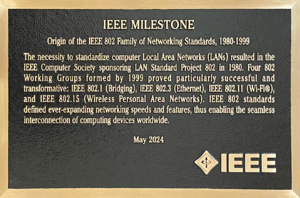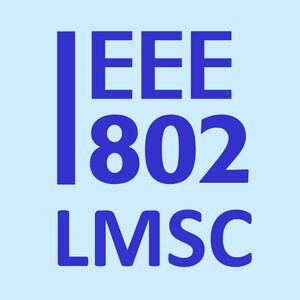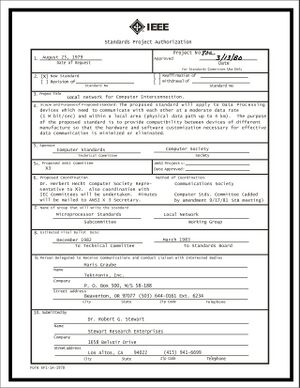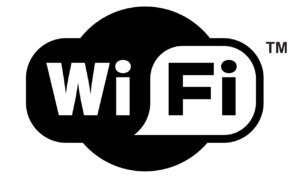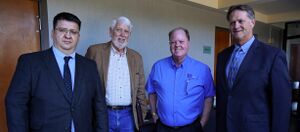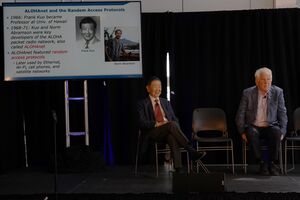Milestones:Origin of the IEEE 802 Family of Networking Standards, 1980-1999
- Date Dedicated
- 2024/05/20
- Dedication #
- 255
- Location
- Mountain View, CA
- IEEE Regions
- 6
- IEEE sections
- Santa Clara Valley
- Achievement date range
- 1980-1999

Title
Origin of the IEEE 802 Family of Networking Standards, 1980-1999
Citation
The necessity to standardize computer Local Area Networks (LANs) resulted in the IEEE Computer Society sponsoring LAN Standard Project 802 in 1980. Four 802 Working Groups formed by 1999 proved particularly successful and transformative: IEEE 802.1 (Bridging), IEEE 802.3 (Ethernet), IEEE 802.11 (Wi-Fi®), and IEEE 802.15 (Wireless Personal Area Networks). IEEE 802 standards defined ever-expanding networking speeds and features, thus enabling the seamless interconnection of computing devices worldwide.
Street address(es) and GPS coordinates of the Milestone Plaque Sites
Computer History Museum, 1401 N. Shoreline Blvd, Mountain View, CA 94043 US (37.414757, -122.077679)
Details of the physical location of the plaque
On the inside face of the front patio brick wall, near the museum's Main Entrance
How the plaque site is protected/secured
Building security; 24/7 access
Historical significance of the work
The work of the IEEE 802 LAN/MAN Standards Committee represents a major technological and economic achievement for voluntary standards because its four Working Groups have developed the technical specifications that are accepted worldwide as defining Media Access Control, and the Physical Layers as implemented within both wired (802.1 and 802.3) and wireless (802.11 and 802.15) network equipment. These standardized interfaces have enabled interoperability amongst multiple vendors, and so in turn have enabled the scalable, complex, yet economical global deployment of communication networks. In the Cisco White Paper (Ref10: Cisco Internet Report), Section 2 ("Network performance and user experience") on pp. 13-18 summarizes the worldwide impact of the 802.11 WG and Wi-Fi, and also shows that every 802.11-compliant device works with packets that have traveled over an 802.3/802.1-compliant wireline infrastructure. The Wi-Fi Alliance Report (Ref9: Economic Value of Wi-Fi) on its opening page shows the 2021 global value of Wi-Fi as $3.3 trillion, and estimates that this value will hit $4.9 trillion in 2025.
Prelude to the Creation of the IEEE 802 Committee After being hired by Tektronix, Inc. in Oregon, Maris Graube led the effort to add support of the IEEE-488 instrumentation interface standard to the company’s products. However, because this standard only supported cable lengths of up to 20 meters, he realized its inadequacy for automating more than a single room of a laboratory.
1979-1980: Creation of the IEEE 802 Committee Graube eventually crossed paths with IEEE member Bob Stuart, who had already played a critical role in initiating a number of standards efforts. When Graube was pondering how to improve upon the limitations of IEEE-488, Stuart suggested to Maris Graube: "Well, why don’t you just form a little standards group?" - and then he helped Graube with filling out and submitting a Standards Project Authorization Request (PAR) form on August 29, 1979, which proposed creation of an IEEE standard for a "Local network for Computer Interconnection."
Because IEEE requires verification of the interest level in creating a new standards project, Graube scheduled an evening meeting on February 28, 1980, concurrent with the spring IEEE Computer Society International Conference (COMPCON) which was being held at the Jack Tar Hotel in San Francisco (which is now the site of the Van Ness Campus Medical Building of the Sutter Health Medical Foundation, which includes a hospital). Graube's records show that at least 79 attended this meeting. As the crowd overflowed into the hallway, the start of the meeting was delayed. Based on at least the number of attendees, the interest level was deemed high enough to go ahead and create an IEEE Project to define a standard for a local area computer network. From Graube's point of view, a network which could connect about 100 devices at a speed of roughly one megabit per second over a kilometer of cabling would be the starting point of the discussion. Ref1: Graube Interview, pp. 2-4
As a result of the interest shown at this meeting, the PAR for the creation of this committee was approved by the IEEE Standards Board as IEEE Standard Project No. 802 on March 13, 1980, with the Technical Committee on Computer Communications (TCCC) of the IEEE Computer Society as its Sponsor. Ref2: PAR 802 Approval
Late 1970s: The Market Was Ready for a LAN Standard In the late 1970s, the computer marketplace was ripe and ready for a multi-vendor interconnection scheme. Earlier mainframe-oriented computer system communication products tended to connect terminals to large host computers, and usually only worked with a single vendor's products. Communication between computers tended to be proprietary and/or oriented to transmission over the 4 kHz voice channel-oriented networks of the legacy telephone system. In addition, the increasing popularity and availability of the 7400 family of small scale ICs, as well as single-chip microprocessors and support chips, led to a plethora of minicomputer startups and products.
It became clear that communication amongst machines from different vendors would be essential, and that a 4 kHz interface would not be adequate. In addition, with the impact of Moore's Law, hobby computers were becoming popular, and the prospect of personal computers in large volume in at least the business environment was beginning to become obvious. Xerox PARC had prototyped a functional equivalent to the personal computer (plus office software) with its Alto personal computer, and had also invented the laser printer. PARC employees demonstrated "The Future of Work" by tying together dozens of these Alto machines and a laser printer using Ethernet. Thus, Ethernet co-inventor Bob Metcalfe and his Xerox colleagues prototyped not only the machine and connection hardware, but also the generalized office usage environment in what it called "The Office of the Future."
Prospective industry support for a local area network standard had been demonstrated by the great interest shown by the many attendees at the February 1980 COMPCON meeting as discussed above. Creation of the IEEE 802 Committee can be seen from two points of view: (1) the pure need point of view from Graube, et al. Ref1: Graube Interview, pp. 15-16, and (2) the proven solution-in-hand point of view from Bob Metcalfe and his former PARC colleagues: "Project 802 got created, the Blue Book got submitted and the meetings started. And with that, war started." Ref3: Metcalfe Oral History, p. 42, Ref4: DIX Ethernet 1980 Blue Book
Work Starts for the IEEE 802 Committee The initial work of IEEE 802 had broad participation and buy-in from many vendors, including smaller computer manufacturers and independent manufacturers of communications interfaces for those computers. The committee's initial goal was a single standard to enable multi-vendor interoperable communication amongst multiple customer systems at high speed, largely in a local or campus context. Ref1: Graube Interview, pp. 16-17
Thus, the 802 Committee's first task was to select the technology and write the specification for what would become "the standard." However, there were immediate problems since Digital Equipment Corp. (DEC), Intel, and Xerox (the "DIX" consortium) had already announced that they intended to publish an interoperability specification before the end of 1980. Ref4: DIX Ethernet 1980 Blue Book
In addition, to no one's surprise, IBM was unwilling to have a hand in creating a singular 802 LAN Standard that wasn't an IBM standard. Further, IBM had two particular problems: (1) they had no proposal ready to go public, and (2) in addition to its "Not Invented Here" (NIH) mindset, Ethernet offered statistical rather than deterministic communication. Ref5: Pelkey Chapter 10.6, pp. 1-2 As a result, the 802 Committee decided to split its efforts into multiple projects: three for differing lower layer access methods: CSMA/CD (802.3), token bus (802.4), and token ring (802.5); and two more: one for a common next layer up, the link layer: (802.2), and internetworking (bridging) at Layer 2 of the ISO 7 Layer Model: (802.1). Ref6: Pelkey Chapter 11.9, p. 7
With this separation, each faction went forward, and the three resulting lower layer standards were each published by the IEEE in 1985 as the following:
- ANSI/IEEE Std 802.3-1985
- IEEE Standards for Local Area Networks:
- Carrier Sense Multiple Access with Collision Detection (CSMA/CD) Access Method and Physical Layer Specifications
- ANSI/IEEE Std 802.4-1985
- IEEE Standards for Local Area Networks:
- Token-Passing Bus Access Method and Physical Layer Specifications
- ANSI/IEEE Std 802.5-1985
- IEEE Standards for Local Area Networks:
- Token ring access method and Physical Layer specifications
With the foundation of the published standards, each group and standard was left on its own to attempt to succeed in the marketplace, with each of the three Working Groups (WGs) tuning its respective standard to its respective market. Each standard was revised by way of amendments (which are listed in the front matter of each standard’s current revision), thus clearing the way for broad market adoption. These were then forwarded for adoption by ISO/IEC JTC-1 as full International Standards (the ISO/IEC 8802 series).
The 1980s: Big Changes in the LAN Industry The 1980s produced significant changes and a shakeout in the LAN industry. In 1984, ownership of customer premises telephone cabling in the U.S. was transferred from AT&T to end customers across the country as part of the breakup of AT&T. Suddenly, excess telephone pairs were available for LAN use, producing a rush to convert LANs to phone wiring. For the 802.3 standard, this was a key turning point which quickly enabled the popularity of 10BASE-T. As the other Physical Layer groups had less internal competition, the shift was less rapid, but the net result was a reduction in their overall market share.
The 1990s: Maturation of the LAN Industry In the early 1990s, the adoption of 100BASE-T created a strong market demand for twisted-pair hubs that were able to handle multiple speeds, which thereby dramatically increased the market for 802.1 Bridging using these central switching elements. This in turn increased the opportunity and market for 802.1 devices as a platform for other Layer 2 software services. The market and interoperability success of the IEEE 802 standards nurtured further amendment projects to increase speeds, and additional standards to add wireless LANs to the IEEE 802 standards family. Ref7: IEEE Computer Magazine, pp. 3-4; Ref8: IEEE Microwave Magazine
The 2000s: The Disbanding of the 802.4 and 802.5 Working Groups The 802.4 standard was withdrawn in 2001 due to lack of activity, and its WG was formally disbanded on Sept, 18, 2004. The 802.5 standard lasted somewhat longer: it was withdrawn on Sept. 26, 2008, and the vote to disband the WG became effective on Oct. 27, 2008. Thus, Ethernet's 802.3 WG had won "the LAN war." In 2012, the addition of full duplex and the long overdue formal addition of EtherType to the 802.3 standard made it appropriate to simplify the title of the 802.3 WG to “Standard for Ethernet.”
The 802.1 Working Group The 802.1 WG deals with bridging between Local Area Networks (LANs), Metro Area Networks (MANs), and Wide Area Networks (WANs). As such, it took on the tasks of defining how to send and receive packets over the media, how to relay packets between network segments (including queuing), and how to determine what protocols would be needed to constrain and control packet forwarding (as handed by projects including 802.1D and 802.1Q). Later projects included how to authenticate devices on the media (802.1X project), how to discover what devices were on the media (802.1AB project), how to provide data integrity and confidentiality on the media (802.1AE project), and many others.
Part of the strength of the IEEE 802 Committee was to decide what needed to be decided where, both above and below the Media Access Control (MAC) service interface. This structure has allowed the other WGs to focus on defining their respective media, and this helped to accelerate the adoption of IEEE 802 technologies. Even while the internet runs on Layer 3/IP forwarding, the basic "LAN Bridge" functions defined by the 802.1 WG are ubiquitous.
The IEEE 802.3 Working Group The public often thinks of a twisted-pair cable with an RJ-45 connector as representing the Ethernet standard. Indeed this cable and connector were in wide use in the early 2000s when IEEE 802.3 Ethernet won "the networking war," which led to the disbanding of the 802.4 and 802.5 WGs. Since that time, IEEE 802.3 Ethernet has grown to address many more application areas, many of which are "under the hood" both figuratively and literally.
IEEE 802.3 Ethernet has always been used in data centers, and many variations and refinements of the Standard have enabled higher speeds to support the increasing centralization of these data centers, their support of the cloud, and streaming services in the wired arena. As proposed in 1980 by the DIX consortium and as included in the first 802.3 spec, Ethernet ran at 10 Mb/s. As of 2017, the 802.3 WG had ratified 200 and 400 Gb/s speeds, an increase of over four orders of magnitude. Efforts were apace in 2023 to standardize 1.6 Tb/s Ethernet, an increase of over five orders of magnitude beyond Ethernet's original speed. Ref11: Evolution of Ethernet.
The IEEE 802.3 Ethernet standard has also been amended to address Access and Carrier networks, with both point-to-point and point-to-multipoint fibre through Ethernet Passive Optical Networks (EPON), Industrial Control, and Automotive networks. Although the latter is a bit of a marketing term, Automotive networks also have applications in trams, trains, trucks, and aircraft. It is important to note that while a particular amendment may be driven by a particular application area, it is all just Ethernet, which can be used almost anywhere. Ref7: IEEE Computer Magazine.
The IEEE 802.11 Working Group A decision by the FCC in 1985 to liberalize the restrictions on devices using unregulated radio bands kicked off a number of projects and startups directed at wireless physical layers for LANs. This in turn resulted in new Work Groups in the 802 Committee to generate wireless LAN standards; the 802.11 WG for Wireless LANs, which allowed Wi-Fi® to become hugely popular for connecting laptops, etc., to Ethernet.
The breadth of the wireless standards work being undertaken by the 802.11 WG as of 2001 is discussed in Ref8: IEEE Microwave Magazine. As of 2023, higher speeds and capacity, along with the ability to integrate services between unregulated and 5G infrastructure, were the core work in the 802.11 wireless arena.
The IEEE 802.15 Working Group The need for simpler, lower power uses, and the popularity of Bluetooth, led to the creation of the 802.15 WG on Wireless Personal Area Networks (WPAN) in 1999. It has produced a number of standards that are widely used in a variety of specialized consumer, commercial, and industrial applications. Ref8: IEEE Microwave Magazine
Later renamed the Wireless Specialty Networks (WSN) WG as the scope and breadth of its standards broadened, the 802.15 WG evolved into a family of standards. The combination of low-power and wireless ad-hoc network attributes enabled unique capabilities such as battery (coin cell) operation for a number of years. 802.15 standards support a variety of network topologies including point-to-point, relay, star, and most importantly mesh. Data rates from several kilobits per second (Kbps) to hundreds of gigabits per second (Gbps) are supported, and these operate in radio frequency bands from hundreds of MHz up to the THz (Tera Hz) range in optical bands. Distances supported with 802.15 standards range from less than a meter to several kilometers.
802.15 standards are ubiquitous in many applications supporting smart home, smart city, smart street, smart energy/utility, industrial lighting, high-speed server interconnect, medical sensor and monitoring, and a variety of sensor and command and control applications with precise ranging at centimeter accuracy. 802.15 ultra-wideband (UWB) technology has been incorporated by numerous cell phone and automobile manufacturers to enable the third generation of wireless key and presence detection, and there are plans for several additional automobile-related applications.
Obstacles (technical, political, geographic) that needed to be overcome
Prior to Project 802 and the creation of the IEEE 802 Committee, most computer-to-computer communication was proprietary, and was oriented to the 4kHz bandwidth of a telephone voice channel from a monopoly provider. The challenge was to change this to a multi-vendor, multi-station network that operated at high speed in a context oriented to a local facility, in particular to overcome the industry's entrenched proprietary bias. A change from circuit-switched to packet switching facilitated this change.
Features that set this work apart from similar achievements
At the time of creation of the IEEE 802 Committee, the major products in the market that were similar were ArcNET (which was proprietary, and largely limited to word processors) and IEEE-488 (which was specific to laboratory instruments, and was oriented to bench-top use). IEEE 802 LANs were to be general purpose and multi-vendor, and have much longer reach than IEEE-488. The worldwide acceptance of the standards that it produces has enabled the IEEE 802 Committee to be the premier LAN standards development arena worldwide.
Significant references
- Ref1: Maris Graube Interview by James L. Pelkey on July 12, 1988: Media:Ref1-Graube-Interview.pdf
- Ref2: IEEE Standards Project Authorization Request (PAR) submitted on Aug. 29, 1979, and approved on March 13, 1980, which approved creation of the IEEE 802 Committee: Media:Ref2-PAR-802-Approval.pdf
- Ref3: Oral History of Robert Metcalfe, interviewed by Len Shustek (Nov. 29, 2006, Jan. 31, 2007): Media:Ref3-Metcalfe-Oral-History.pdf
- Ref4: DEC/Intel/Xerox (DIX) Ethernet Spec Ver. 1.0, Sept. 30, 1980 ("The Blue Book") Media:Ref4-DIX-Ethernet-1980.pdf
- Ref5: History of Computer Communications, Chapter 10.6: The IBM PC and IBM’s Token Ring LAN 1981-1982 Media:Ref5-Pelkey-Chapter-10.6.pdf
- Ref6: History of Computer Communications, Chapter 11.9: IEEE Committee 802: 1981-1982 Media:Ref6-Pelkey-Chapter-11.9.pdf
- Ref7: IEEE Computer Magazine story (c) 2019: Ethernet: From Office to Data Center to IoT, Geoff Thompson, Past Chair, IEEE 802.3 Working Group Media:Ref7-IEEE-Computer-Magazine.pdf (Note: Geoff Thompson is this Milestone's proposer, and he grants the royalty-free right to use this story for any use related to an IEEE Milestone.)
- Ref8: IEEE Microwave Magazine story (c) 2001: Standards from IEEE 802 Unleash the Wireless Internet, Roger B. Marks, Ian C. Gifford, and Bob O’Hara Media:Ref8-IEEE-Microwave-Paper.pdf
- Ref9: Economic Value of Wi-Fi (c) 2021: Wi-Fi Alliance Report: Global Economic Value of Wi-Fi, 2021-2025 (Sept. 2021) Media:Ref9-Global_Economic_Value_of_Wi-Fi_2021-2025.pdf
- Ref10: Cisco Internet Report (c) 2020: Cisco Annual Internet Report (2018-2023) Media:Ref10-Cisco_Annual_Internet_Report_White-Paper_March-2020.pdf
Supporting materials
See references
Dedication Ceremony
A Celebration of 50 Years of the Internet
- Blog with Photos from "50 Years of the Internet" Event
- Eileen Clegg's Internet Evolution Tapestry as discussed by her and Vint Cerf
Martin Wasserman Interviews re: the 50th Anniversary of the Internet
- Internet Pioneer Vint Cerf
- Internet Historian Marc Weber
- IEEE History Committee Vice Chair Brian Berg
Map













